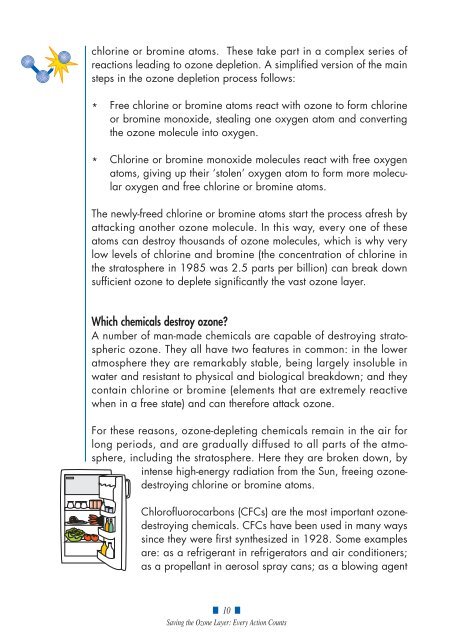Saving the Ozone Layer: Every Action Counts
Saving the Ozone Layer: Every Action Counts
Saving the Ozone Layer: Every Action Counts
Create successful ePaper yourself
Turn your PDF publications into a flip-book with our unique Google optimized e-Paper software.
chlorine or bromine atoms. These take part in a complex series of<br />
reactions leading to ozone depletion. A simplified version of <strong>the</strong> main<br />
steps in <strong>the</strong> ozone depletion process follows:<br />
* Free chlorine or bromine atoms react with ozone to form chlorine<br />
or bromine monoxide, stealing one oxygen atom and converting<br />
<strong>the</strong> ozone molecule into oxygen.<br />
* Chlorine or bromine monoxide molecules react with free oxygen<br />
atoms, giving up <strong>the</strong>ir ‘stolen’ oxygen atom to form more molecular<br />
oxygen and free chlorine or bromine atoms.<br />
The newly-freed chlorine or bromine atoms start <strong>the</strong> process afresh by<br />
attacking ano<strong>the</strong>r ozone molecule. In this way, every one of <strong>the</strong>se<br />
atoms can destroy thousands of ozone molecules, which is why very<br />
low levels of chlorine and bromine (<strong>the</strong> concentration of chlorine in<br />
<strong>the</strong> stratosphere in 1985 was 2.5 parts per billion) can break down<br />
sufficient ozone to deplete significantly <strong>the</strong> vast ozone layer.<br />
Which chemicals destroy ozone?<br />
A number of man-made chemicals are capable of destroying stratospheric<br />
ozone. They all have two features in common: in <strong>the</strong> lower<br />
atmosphere <strong>the</strong>y are remarkably stable, being largely insoluble in<br />
water and resistant to physical and biological breakdown; and <strong>the</strong>y<br />
contain chlorine or bromine (elements that are extremely reactive<br />
when in a free state) and can <strong>the</strong>refore attack ozone.<br />
For <strong>the</strong>se reasons, ozone-depleting chemicals remain in <strong>the</strong> air for<br />
long periods, and are gradually diffused to all parts of <strong>the</strong> atmosphere,<br />
including <strong>the</strong> stratosphere. Here <strong>the</strong>y are broken down, by<br />
intense high-energy radiation from <strong>the</strong> Sun, freeing ozonedestroying<br />
chlorine or bromine atoms.<br />
Chlorofluorocarbons (CFCs) are <strong>the</strong> most important ozonedestroying<br />
chemicals. CFCs have been used in many ways<br />
since <strong>the</strong>y were first syn<strong>the</strong>sized in 1928. Some examples<br />
are: as a refrigerant in refrigerators and air conditioners;<br />
as a propellant in aerosol spray cans; as a blowing agent<br />
■ 10 ■<br />
<strong>Saving</strong> <strong>the</strong> <strong>Ozone</strong> <strong>Layer</strong>: <strong>Every</strong> <strong>Action</strong> <strong>Counts</strong>
















